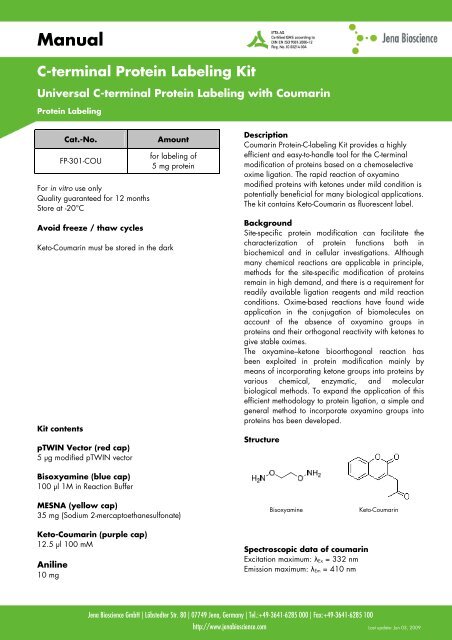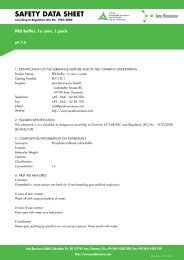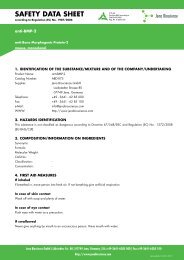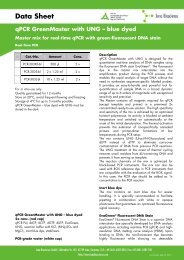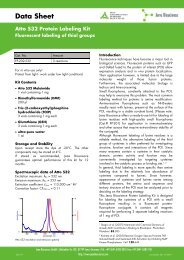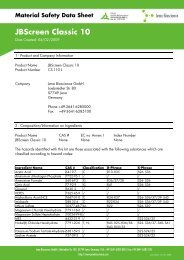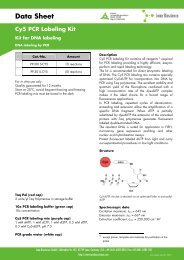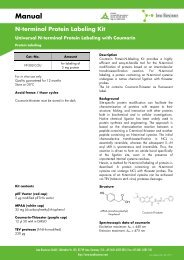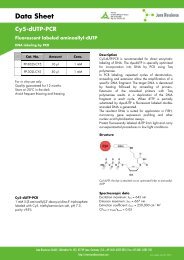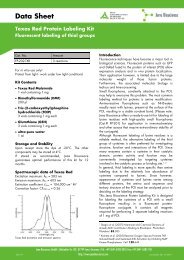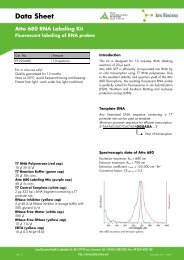Manual C-terminal Protein Labeling Kit - Jena Bioscience
Manual C-terminal Protein Labeling Kit - Jena Bioscience
Manual C-terminal Protein Labeling Kit - Jena Bioscience
You also want an ePaper? Increase the reach of your titles
YUMPU automatically turns print PDFs into web optimized ePapers that Google loves.
<strong>Manual</strong><br />
C-<strong>terminal</strong> <strong>Protein</strong> <strong>Labeling</strong> <strong>Kit</strong><br />
Universal C-<strong>terminal</strong> <strong>Protein</strong> <strong>Labeling</strong> with Coumarin<br />
<strong>Protein</strong> <strong>Labeling</strong><br />
Cat.-No. Amount<br />
FP-301-COU<br />
For in vitro use only<br />
Quality guaranteed for 12 months<br />
Store at -20°C<br />
Avoid freeze / thaw cycles<br />
for labeling of<br />
5 mg protein<br />
Keto-Coumarin must be stored in the dark<br />
<strong>Kit</strong> contents<br />
pTWIN Vector (red cap)<br />
5 µg modified pTWIN vector<br />
Bisoxyamine (blue cap)<br />
100 µl 1M in Reaction Buffer<br />
MESNA (yellow cap)<br />
35 mg (Sodium 2-mercaptoethanesulfonate)<br />
Keto-Coumarin (purple cap)<br />
12.5 µl 100 mM<br />
Aniline<br />
10 mg<br />
Description<br />
Coumarin <strong>Protein</strong>-C-labeling <strong>Kit</strong> provides a highly<br />
efficient and easy-to-handle tool for the C-<strong>terminal</strong><br />
modification of proteins based on a chemoselective<br />
oxime ligation. The rapid reaction of oxyamino<br />
modified proteins with ketones under mild condition is<br />
potentially beneficial for many biological applications.<br />
The kit contains Keto-Coumarin as fluorescent label.<br />
Background<br />
Site-specific protein modification can facilitate the<br />
characterization of protein functions both in<br />
biochemical and in cellular investigations. Although<br />
many chemical reactions are applicable in principle,<br />
methods for the site-specific modification of proteins<br />
remain in high demand, and there is a requirement for<br />
readily available ligation reagents and mild reaction<br />
conditions. Oxime-based reactions have found wide<br />
application in the conjugation of biomolecules on<br />
account of the absence of oxyamino groups in<br />
proteins and their orthogonal reactivity with ketones to<br />
give stable oximes.<br />
The oxyamine–ketone bioorthogonal reaction has<br />
been exploited in protein modification mainly by<br />
means of incorporating ketone groups into proteins by<br />
various chemical, enzymatic, and molecular<br />
biological methods. To expand the application of this<br />
efficient methodology to protein ligation, a simple and<br />
general method to incorporate oxyamino groups into<br />
proteins has been developed.<br />
Structure<br />
Bisoxyamine Keto-Coumarin<br />
Spectroscopic data of coumarin<br />
Excitation maximum: λEx = 332 nm<br />
Emission maximum: λEm = 410 nm<br />
<strong>Jena</strong> <strong>Bioscience</strong> GmbH | Löbstedter Str. 80 | 07749 <strong>Jena</strong>, Germany | Tel.:+49-3641-6285 000 | Fax:+49-3641-6285 100<br />
http://www.jenabioscience.com Last update: Jun 03, 2009
<strong>Manual</strong><br />
C-<strong>terminal</strong> <strong>Protein</strong> <strong>Labeling</strong> <strong>Kit</strong><br />
Universal C-<strong>terminal</strong> <strong>Protein</strong> <strong>Labeling</strong> with Coumarin<br />
<strong>Protein</strong> <strong>Labeling</strong><br />
Procedure<br />
<strong>Protein</strong> Preparation with C-<strong>terminal</strong>-thioesther<br />
1. Clone target gene into modified pTWIN vector<br />
using NdeI and SapI sites.<br />
2. Express fusion protein (target-Intein-His) in<br />
BL21(DE3) cells.<br />
3. Collect cells in 25 mL ice-cold Breaking Buffer<br />
freshly supplemented with 1 mM PMSF.<br />
CRITICAL: PMSF should be added freshly. Don’t<br />
add any reducing substances.<br />
4. Lyse cells using a microfluidizer or ultrasonication.<br />
5. Add 1% Triton X-100 into cell lysate and<br />
centrifuge at 35,000 rpm, 4°C for 30 min.<br />
6. Filter supernatant through a 0.2 μm filter.<br />
7. Load cell lysate onto a Ni-NTA column<br />
equilibrated with Buffer A.<br />
8. Wash column with Buffer A and continue with<br />
2% Buffer B until absorbance reaches baseline.<br />
9. Elute column with a gradient of 2-100% Buffer B.<br />
Collect eluted fractions.<br />
10. Identify and collect fractions of interest by SDS-<br />
PAGE.<br />
11. Add MESNA powder to protein solution to a<br />
concentration of 0.5 M and incubate overnight at<br />
20 °C.<br />
12. Dilute solution with 5-fold volume of Buffer A<br />
13. Load them onto a Ni-NTA column equilibrated<br />
with Buffer A containing 10 mM MESNA.<br />
Collect flow-through.<br />
14. Wash column with 2-5% Buffer B containing 10<br />
mM MESNA. Collect and pool flow-through and<br />
concentrate protein.<br />
15. Run a gel filtration on a Superdex column using<br />
Elution Buffer.▲CRITICAL: Prepare fresh solution,<br />
filter buffer through a 0.2 μm filter and degas on<br />
a vacuum-membrane pump by stirring for 0.5 h at<br />
room temperature.<br />
16. Identify and collect fractions of interest by SDS-<br />
PAGE. Concentrate protein and snap-freeze in<br />
liquid nitrogen. Store protein at -80°C.<br />
<strong>Protein</strong> C-<strong>terminal</strong> <strong>Labeling</strong><br />
17. Incubate 200 µl protein-thioester (5-25 mg/ml)<br />
with 100 µl Bisoxyamine (1 M stock solution in<br />
reaction buffer, final 333 mM) in Reaction<br />
Buffer on ice overnight.<br />
The reaction is monitored by ESI-MS.<br />
18. Dialyze protein twice against 1 L Dialysis<br />
Buffer at 4 °C.<br />
19. Incubate 50 µM protein-ONH2 with 0.5 mM<br />
Keto-Coumarin for 20 h or 1 mM Keto-<br />
Coumarin overnight on ice in the presence of<br />
100 mM Aniline in Incubation Buffer.<br />
CRITICAL: If your protein can tolerate an acidic<br />
environment, the reaction can also be performed<br />
by incubating 50 µM protein-ONH2 with 1 mM<br />
Keto-Coumarin for 4 h in NaAc Buffer.<br />
20. Remove excess dye using a desalting column preequilibrated<br />
in Dialysis Buffer.<br />
<strong>Jena</strong> <strong>Bioscience</strong> GmbH | Löbstedter Str. 80 | 07749 <strong>Jena</strong>, Germany | Tel.:+49-3641-6285 000 | Fax:+49-3641-6285 100<br />
http://www.jenabioscience.com Last update: Jun 03, 2009
<strong>Manual</strong><br />
C-<strong>terminal</strong> <strong>Protein</strong> <strong>Labeling</strong> <strong>Kit</strong><br />
Universal C-<strong>terminal</strong> <strong>Protein</strong> <strong>Labeling</strong> with Coumarin<br />
<strong>Protein</strong> <strong>Labeling</strong><br />
To be provided<br />
Breaking Buffer<br />
25 mM NaH2PO4 pH 7.5, 0.5 M NaCl<br />
PMSF<br />
Triton X-100<br />
Buffer A<br />
50 mM NaH2PO4 pH 8.0, 0.3 M NaCl<br />
Buffer B<br />
50 mM NaH2PO4 pH 8.0, 0.3 M NaCl,<br />
0.5 M imidazole<br />
Elution Buffer<br />
30 mM NaH2PO4 pH 7.5, 50 mM NaCl,<br />
10 mM MESNA<br />
Reaction Buffer<br />
30 mM NaH2PO4 pH 7.5, 50 mM NaCl<br />
Dialysis Buffer<br />
30 mM NaH2PO4 pH 7.5, 50 mM NaCl, 2 mM DTE<br />
Incubation Buffer<br />
30 mM NaH2PO4 pH 7.0, 50 mM NaCl, 2 mM DTE<br />
NaAc Buffer<br />
50 mM NaAc pH 5.5, 50 mM NaCl, 2 mM DTE<br />
<strong>Jena</strong> <strong>Bioscience</strong> GmbH | Löbstedter Str. 80 | 07749 <strong>Jena</strong>, Germany | Tel.:+49-3641-6285 000 | Fax:+49-3641-6285 100<br />
http://www.jenabioscience.com Last update: Jun 03, 2009
<strong>Manual</strong><br />
C-<strong>terminal</strong> <strong>Protein</strong> <strong>Labeling</strong> <strong>Kit</strong><br />
Universal C-<strong>terminal</strong> <strong>Protein</strong> <strong>Labeling</strong> with Coumarin<br />
<strong>Protein</strong> <strong>Labeling</strong><br />
Selected References<br />
Yi, L. et al. (2010) A Highly Efficient Strategy for Modification of<br />
<strong>Protein</strong>s at the C Terminus. Angewandte Chemie Int. Ed. 49:9417.<br />
Yi, L. et.al. (2011) One-Pot Dual-<strong>Labeling</strong> of a <strong>Protein</strong> via Two<br />
Chemoselective Reactions. Angewandte Chemie Int. Ed. 50: 8287.<br />
<strong>Jena</strong> <strong>Bioscience</strong> GmbH | Löbstedter Str. 80 | 07749 <strong>Jena</strong>, Germany | Tel.:+49-3641-6285 000 | Fax:+49-3641-6285 100<br />
http://www.jenabioscience.com Last update: Jun 03, 2009


